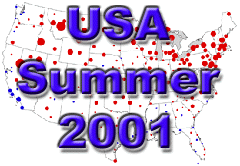|
SUMMER 2001 FIFTH WARMEST ON RECORD FOR U.S. CONDITIONS DRY IN THE NORTHWEST, WET IN SOUTHERN GULF
The preliminary nationally averaged temperature was 73.6 F (23.1 C), which was 1.5 F (0.8 C) above the long-term mean. June through August temperatures have been above average in 11 of the past 15 years. Temperatures were generally above normal nationally, however, cooler temperatures than average were seen in much of the Southeast. The summer's most notable heat wave in late July and early August began in the southern Plains and stretched into the upper Midwest, with higher-than-normal temperatures extending into the northeastern U.S. by the second week of August. Daily high temperatures in the 90s and 100s, combined with high humidity, led to dangerous heat stress levels and numerous heat-related deaths. August 2001 ranked as the fourth warmest in written records. The preliminary nationally averaged temperature was 74.9 F (23.8 C), which was 2.1 F (1.2 C) above the long-term mean. Coastal California was notably cooler than average with slightly below-average temperatures widespread across parts of the South from Louisiana to Alabama. Much of the nation was warmer than normal, with monthly anomalies greater than 5 F in parts of the Northeast and West. National precipitation was 8.4 inches during the June-August period, which is near the long-term mean of 8.2 inches. Regional precipitation was above average in parts of the Southeast and Midwest as well as in the extreme Northwest and northern Plains. The wettest weather occurred along the central Gulf Coast region, as tropical storms Allison and Barry brought heavy rains during June and August, respectively. Precipitation in the West did little to alleviate long-term drought conditions, which worsened in many parts of the Northwest. By the end of August, moderate to extreme drought conditions covered much of that region, as well as western Wyoming and Montana. The extended period of drier-than-normal conditions, which affected some of the same areas in the summer of 2000, was a contributing factor to wildfires that burned more than one million acres in the West. However, according to the National Interagency Fire Center, on a national basis in 2001, the number of acres burned through the end of August was less than the 10-year average of 3.4 million acres and much less than the nearly 6.9 million acres burned by wildfire in 2000. Based on preliminary precipitation data, August was drier than average, ranking thirty-ninth since 1895. Below-normal precipitation generally occurred in the West, portions of the Southeast and Northeast, with wetter than average conditions stretching from Wisconsin to the Deep South. Precipitation in Puerto Rico was near normal while conditions in Alaska and Hawaii were mixed. NCDC is a part of NOAA's National Environmental Satellite, Data, and Information Service, the nation's primary source of space-based meteorological and climate data. NESDIS operates the nation's environmental satellites, which are used for weather forecasting, climate monitoring and other environmental applications such as fire detection, ozone monitoring and sea surface temperature measurements. NESDIS also operates three data centers that which house global data bases in climatology, oceanography, solid earth geophysics, marine geology and geophysics, solar-terrestrial physics, and paleoclimatology. Relevant Web Sites
|
